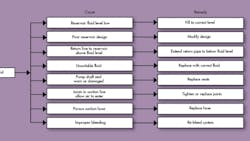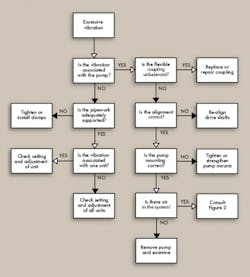Think First, Then Troubleshoot — Chapter 5: Excessive Vibration
It is always important to remember that a hydraulic system consists of many mechanical components. Mechanical components are subject to mechanical problems, vibration being a case in point.
Technically, excessive vibration is a mechanical, not a hydraulic problem. In a well-designed hydraulic system, vibration is neither identified with nor related to the shifting action of hydraulic controls, the linear movement of cylinders, the rotation of pumps and motors, or the oil itself. Yet, mechanical imbalance – which results in vibration – can and often is the cause of hydraulic problems that maintenance people must troubleshoot and deal with. A detailed troubleshooting procedure for excessive vibration appears in Figure 7.
Figure 7 – Pinpointing causes of vibration problems. Click on image for larger view.Long-term consequences — The trouble is that engineers often tend to design to resolve an immediate problem, but frequently fail to consider the longer-term consequences of their designs. One example of lack of design foresight is component inaccessibility on many machines. Replacing a pump and achieving the required alignment of electric motor and hydraulic pump – to avoid vibration – in a machine is often difficult and sometimes nearly impossible if electric motors and pumps are buried inside the machine. The initial assembly is made without problems, but after other machine elements are in place, maintenance, repair, and replacement becomes a headache.
The designer should have anticipated a potential long-term maintenance problem, and not just designed for an easy, short-term assembly solution. A makeshift fix may be a relatively cheap short-term cure, but can become very expensive in the long run.
Don’t keep it a secret — Maintenance personnel should be encouraged to think about causes and prevention of equipment problems, and to communicate their thoughts, observations, and ideas to their company’s management. It is management’s responsibility to review and evaluate suggestions submitted by the maintenance department, and to consider reported design short-comings when planning future equipment purchases. Otherwise, problems are just perpetuated.
About the Author
Alan Hitchcox Blog
Editor in Chief
Alan joined Hydraulics & Pneumatics in 1987 with experience as a technical magazine editor and in industrial sales. He graduated with a BS in engineering technology from Franklin University and has also worked as a mechanic and service coordinator. He has taken technical courses in fluid power and electronic and digital control at the Milwaukee School of Engineering and the University of Wisconsin and has served on numerous industry committees.

Leaders relevant to this article:

